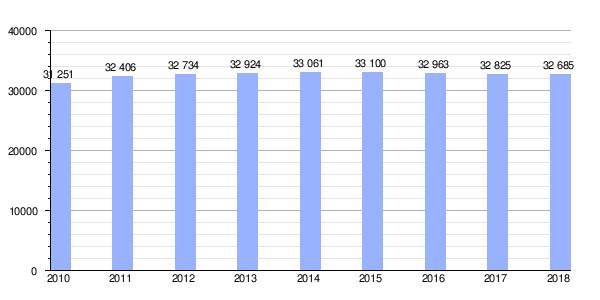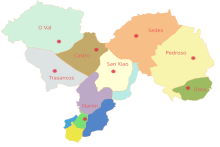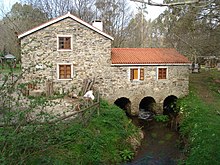Naron
Narón is a Spanish municipality and town located in the north of the province of La Coruña, in the autonomous community of Galicia. It is located between the Atlantic Ocean and the Ferrol estuary, in the Ferrol region.
According to the INE, in 2022 it had a population of 38,938 inhabitants, being the eighth most populous municipality in Galicia and the fourth in the province of La Coruña after La Coruña, Santiago de Compostela and Ferrol.
Toponymy
It is a hydronym of pre-Roman origin, from the Paleo-European form *nar-, derived from the Indo-European root *ner- 'to penetrate, submerge, hide, hollow ', identified by Pokorny, who related it to several Baltic rivers.
Philologists such as Bascuas have defended this origin, being an example of the alternating inflection -a / -ón, characteristic of Paleo-European hydronymy.
Within the series of hydronyms derived from this form *nar- would be the rivers Neira, a tributary of the Miño, Naraya and Narayola (León), Narcea (Asturias) and other hydronyms such as Naraval, in Asturias. Likewise, other place names would be found such as Naraío (Ferrol), Naraído (Trabada), Naraxa (Fonsagrada).
On the other hand, other authors have derived it from an anthroponym, either from Naro, -onis, or from Naronius.
Geography
Its surface area of 66.91 km² extends around the valley formed by the mouth of the Jubia River. It is limited by the Atlantic Ocean and by the municipalities of Ferrol, Neda, San Saturnino and Valdoviño. The north coast area is high and abrupt, formed by cliffs. The southern area is located within the Ferrol estuary, where the Jubia river flows through the municipality. These characteristics are what make it only have three small beaches, including O Casal, a cove that is difficult to access.
The municipal term is adjacent to those of Ferrol, Valdoviño, San Saturnino and Neda. It is located to the northwest of the province of La Coruña, on the northern shore of the Ferrol estuary, and is part of the commonwealth of the estuary and the region of Ferrol.
This town hall stands out for its natural landscapes, especially the coastal ones, many of which are barely accessible. These are located in the parish of Santa María la Mayor de O Val, where the beaches of El Casal, Espiñaredo and La Lopesa are located, where there are remains of a castro.
The highest point in the municipality of Narón is Monte dos Nenos (367 m), in the parish of Sedes, from where you can see a wide view of the Ferrol region.
The municipality has high-capacity expressways, since the AP-9 motorway crosses the urban center, it has two branches that connect the Río del Pozo business park with the motorway and the Narón ring road. It also passes the Ferrol - Villalba highway and the FEVE Ferrol - Gijón road has several halts in the municipality.
The municipality of Narón suffers from a serious urban disorder generated by the urban corruption prevailing in Spain in the last decades of the XX century, creating an authentic urban center around the Carretera de Castilla. Examples of this are the high voltage lines that until recently passed through the middle of populous neighborhoods, the Adif and FEVE roads that act as a barrier between neighborhoods and numerous dead-end streets with few facilities. However, due to the exponential population growth that has occurred in the first decade of the XXI century, important disbursements by the city council, Junta de Galicia and provincial council in order to alleviate these facts. An example of this is the adaptation of the land through which the AP-9 motorway currently runs, under which a large municipal park has been formed, the sanitation improvement works in the Freixeiro, Xubia or Piñeiros neighborhoods, among others; works that have been carried out in the last year.
History
It is a mixed municipality, with seven eminently rural parishes in which less than a quarter of the population live and with an urban nucleus of more than 30,000 inhabitants made up of the neighborhoods of La Gándara, La Solaina, El Alto del Castaño, Piñeiros, O Couto, Freixeiro and Jubia, the first four standing out for their population.
Demographics
As of January 1, 2013, the population of the municipality amounted to 39,450 inhabitants, 19,197 men and 20,253 women. Likewise, the City Council maintains that it has exceeded 40,000 inhabitants, having carried out a large government campaign to celebrate it.
Municipality
| Graphic of demographic evolution of Narón (municipality) between 1900 and 2018 |
 |
Population of Law (1900-1991) or resident population (2001) according to population censuses of the INE. Population according to the 2013 municipal plan of the INE. |
Town
| Graphic of demographic evolution of Narón (locality) between 2010 and 2018 |
 |
Data according to the nomenclator published by the INE. |
The town, and capital of the municipality, was formed in 2010 with the union of six of the thirteen parishes of the municipality, which have become neighborhoods of the town:
- Jubia (Our Lady of the Displaced), present neighborhood of Piñeiros.
- San José Obrero de Jubia, present district of Alto del Castaño.
- San Martín de Jubia, current O Couto neighborhood.
- Santa Cecilia de Jubia, present neighborhood of La Solana.
- Santa Rita de Jubia, current district of Jubia.
- Santiago Apostle of Jubia, present district of La Gándara.
Parishes
According to the 2019 gazetteer, the municipality includes the town of Narón as well as 7 parishes.
- Castro (Santa Maria)
- Two.San Lourenzo)
- Narón (San Xiao)
- Pedroso (San Salvador)
- Headquarters (Holy Estevo)
- Trasancos (San Mateo)
- Val (Santa Maria a Maior)
Economy
It is a population that still maintains characteristics of its origin as a commuter town of Ferrol, which also lived from the naval sector, and that little by little has been diversifying its industrial and leisure activities, positioning itself as one of the strongest economic municipalities from Galicia.
Río del Pozo, one of the largest industrial estates in all of Galicia, is located in Narón, where important companies such as Inditex, Megasa and Lidl have settled. There are also two other industrial estates: La Gándara, where the largest shopping center in the region is located, C.C. Odeón, and the As Lagoas industrial estate, where there is one of the two cement factories in this municipality.
Culture
The municipality has one of the largest theaters and cultural centers in all of Galicia, the Pazo da Cultura, in addition to already having a library in Alto del Castaño and a theme park of the rural world called "Aldea Nova" (in Headquarters) currently managed by a private company that carries out activities related to the environment. However, Aldea Nova had several problems in the past as a result of its mismanagement, which led to abandonment and neglect of the administration towards the animals that were there, as well as the non-payment of workers' wages for at least two years.
Narón musically features the composition in the form of a pasodoble with the title “Narón, Terra de Trasancos” by the professor and composer Miguel Brotóns. Composition created and edited by the City Council itself in 2006, with the purpose of representing and extolling the municipality of Narón in all kinds of public events.
Sports
The most important clubs are Baloncesto Narón, from the EBA League, Cidade de Narón, which competes in the Second Division of the National Futsal League, the second category of Spanish futsal, with a branch in the Autonomous League, Narón Balompié Piñeiros, from the Segunda Autonómica, Football Group I, and Balonmano Narón, a great handball club. As well as a swimming club that is struggling to climb to the division of honor, the A.D Náutico de Narón. In addition to the Afflelou Narón Athletics Club, which in the 2010/2011 season has achieved promotion to the First Division, the second category of Spanish athletics. In 2014, the Narón City Council allocated 307,500 euros to collaboration agreements with sports clubs in the municipality. In Narón there is also a rally of the Galician competition, the Narón Rally. They also have the covered sports center of La Gándara, which consists of a heated swimming pool, a central court for sports such as handball, five-a-side football or basketball, among others, a weights room and a sauna. In this pavilion the training sessions of the Arco Narón Club are carried out, which has outstanding archers.
In the parish of O Val is the Club Campomar golf course.
Leisure
There are several recreational areas such as the Pedroso mill (which also has a campsite), La Picota, in El Coto and the Rey Dam in Xubia. There is also an urban park on the banks of the Freixeiro river, next to which one of the largest housing estates in the region (Residencial Las Torres) has been built.
In the city it is possible to find two shopping centers; the largest is Odeón, which is located in the A Gándara industrial estate, which it shares with other companies, such as Eroski, Alcampo, Mercadona or Lidl. In this center we can find a wide variety of fashion and accessories stores, cafeterias, game rooms and a 12-screen cinema. The second shopping center in Narón, much smaller than Odeón, is located in El Barrio O Alto do Castiñeiro, in the same square where the town hall building is located. This place has a hypermarket from the Froiz chain and small stores, mainly focused on food and fashion accessories.
Along the Carretera de Castilla, from the Jubia neighborhood to the Piñeiros neighborhood, there are many pubs and cafeterias, especially crowded during weekend nights.
Monuments and places of interest
The constructions of its urban nucleus are essentially from the end of the 20th century and current, but within the limits of the municipality you can see some historical buildings such as the monastery of San Martín de Jubia (probably prior to the 12th century in its origin) or the fluvial and tide mills from the 18th century on the banks of the two main river basins of the municipal area: the Rio Grande de Jubia and the Freixeiro River.
From a tourist and leisure point of view, its main attractions are:
- Molino de Pedroso and his rest area, on the banks of the Jubia River in the parish of Pedroso.
- Promenade of Jubia, between the mills of Jubia and As Aceas, one of the few preserved in Galicia that operated with the force of the tides.
- Parque del Río Freixeiro, parallel to the urban center.
- Church and Monastery of San Martín de Jubia, of Romanesque art with additions of the Galician Baroque of the seventeenth and eighteenth centuries. Declared well of cultural interest.
- We bring the Pilgrim Way to San Andrés de Teixido and the English Way to Santiago de Compostela.
- Aldea Nova, the theme and educational park on the rural world in Galicia located in the parish of Headquarters.
- Pazo Libunca, civil construction of the early twentieth century with elements of the indiana and modernist architecture located in the place of Pena de Embade, between the parishes of San Julián de Narón and Castro. It currently operates as a hotel and hospitality establishment.
- Nightlife zones around the Castile Road, in the neighborhoods of Piñeiros and Jubia, the commercial area around C.C.Odeón and the Polígono de A Gándara, in the district of A Gándara.
- Odeón Shopping Center, located in the neighborhood of La Gándara. It has businesses such as H fakeM, Zara, Mango, Tous, etc., plus a cinema of more than 10 rooms.
- Cliffs and coves in the parish of O Val that are part of the LIC Costa Ártabra (Red Natura 2000).
Used bibliography
- National Institute of Statistics. "INEbase / Nomenclator. Relation of population units». Consultation on 21 April 2012.
- Madoz, Pascual (1845-1850), «NARON», Geographic-statistic-historic dictionary of Spain and its possessions of Ultramar, 16 tomos, Madrid: Literary-typed establishment of P. Madoz and L. Sagasti.
- Parishs on the Naron City Hall website (in Galician)
Contenido relacionado
Land
Cadiz Province
Albania




